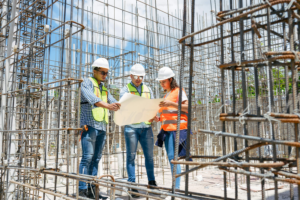Construction workers are the backbone of building projects, transforming architectural blueprints into tangible structures. These skilled professionals possess expertise across various disciplines, including excavation, foundation laying, carpentry, framing, and roofing. Contact Diversified Management & Construction, Inc. now!
Whether they work on residential or commercial projects, their work is felt well beyond the chain-link fence surrounding the job site. Each new building brings employment opportunities, increased spending by occupants and community improvements.

The process of planning construction work is an essential part of a project. It involves defining the various work tasks that must be accomplished, estimating resources for each of those activities and identifying required or preferred sequences or precedences. It also includes establishing a process for revising the construction plan as work progresses.
Construction planning is generally performed by a team of people, including project managers, engineers, cost estimators, builders and on-site workers. Ideally, the team members will meet regularly to discuss the progress of the project and ensure that the construction schedule is kept up to date.
There are many different methods for preparing a construction plan, each with its own advantages and disadvantages. Some methodologies focus on a single aspect of the project while others are more holistic in their approach. The choice of methodology will typically depend on the size, importance and difficulty of the project as well as the particular scheduling and accounting procedures adopted.
Detailed work breakdowns are essential for constructing a construction plan, but a careful balance must be maintained between the level of detail and the time required to prepare the work break down. Detailed task definitions can be very useful in communicating the construction plan, facilitating construction monitoring and enabling progress payments to be made to the owner. However, they can only be of value if the resource requirements, durations and activity relationships are realistically estimated for each of the work activities.
It is important to understand the risks associated with a construction project and to develop mitigation strategies. This may involve conducting risk assessments, creating contingency plans and implementing quality assurance procedures. The planning process also involves determining the project budget and ensuring that it is sustainable throughout the construction period.
Resource planning is an integral part of the construction planning process and involves assessing available workforce and equipment and determining what other resources are required to complete the project on time. This is important because underestimating resource requirements can lead to delays, increased costs and ultimately project failure. It is also important to take into account the impact of the construction project on existing workloads and company policies.
Construction projects are inherently risky and unforeseen challenges can arise at any point. Consequently, it is important to create a contingency plan that can minimize the impact of these unforeseen events on the project schedule and budget.
One of the best ways to identify potential obstacles is through expert judgment, which can be a valuable tool for estimating timelines and budgets. By leveraging the knowledge of experienced engineers, project managers and skilled tradespeople, you can build more realistic timelines that factor in potential roadblocks. Another great way to avoid overestimating project costs is through historical data analysis. By analyzing data from previous projects of similar scope and complexity, you can better estimate how much to budget for each phase of your construction project.
Design
Construction encompasses a broad range of processes from the design and development of infrastructure and buildings to their eventual demolition or decommissioning. It’s a complex industry that involves many different people, tools, and materials to bring ideas to life. When it comes to construction, the design phase is one of the most important aspects of any project. It’s what makes the difference between a successful project and a failure. The design process takes time and requires expert engineering, so it’s vital that all parties involved are on the same page from the start.
To ensure that innovative designs are feasible, engineers must be able to analyze their constructability. This involves evaluating the project’s technological requirements for operation or production, design capabilities, and construction technology. Depending on the type of project, it may also involve strategic decisions regarding how the facility will be built such as whether to prefabricate components or on-site assembly.
Another crucial part of the design phase is considering all potential impacts on the project schedule. For example, if the contractor has to wait on a particular part of the design or on the completion of certain specifications, this could have significant implications for the project’s timeline. The construction team can address these issues early on during the programming phase so that they can make informed design choices and reduce delays.
Programming is a key stage in the design process, and it’s an essential part of any construction project. It’s a time when the construction team and the architect explore what the project will require, such as how many rooms are needed or if any special spaces are required, like cleanrooms. This information will help the architects create a detailed building plan that can be used as a guide throughout construction.
Construction is more than just a practical business—it’s a form of artistic expression. It allows engineers and designers to push the limits of what’s possible, creating new and exciting structures that stand out from the crowd. From the Burj Khalifa in Dubai to the Shanghai Tower in China, these structures are a testament to the endless possibilities of modern construction.
As anyone who’s been through a construction project knows, clear communication is critical for success. The design-build model fosters open lines of communication from day one, eliminating the bidding process and the lengthy negotiations that often occur with traditional projects. This results in faster project delivery, fewer cost overruns, and a smoother process overall. With everyone working as a single unit, the construction team can identify any potential problems quickly and communicate solutions effectively. This helps to prevent misunderstandings and delays that can derail any project.